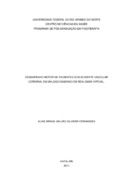Please use this identifier to cite or link to this item:
https://repositorio.ufrn.br/handle/123456789/16713| Title: | Desempenho motor de pacientes com acidente vascular cerebral em um jogo baseado em realidade virtual |
| Authors: | Fernandes, Aline Braga Galvão Silveira |
| Advisor: | Campos, Tânia Fernandes |
| Keywords: | modalidades de fisioterapia;transtornos cerebrovasculares;extremidade superior;atividades cotidianas;biomecânica;hemiparesia;physical therapy modalities;cerebrovascular disorders;upper extremity;activities of daily living;biomechanics;hemiparesis |
| Issue Date: | 19-Dec-2011 |
| Publisher: | Universidade Federal do Rio Grande do Norte |
| Citation: | FERNANDES, Aline Braga Galvão Silveira. Desempenho motor de pacientes com acidente vascular cerebral em um jogo baseado em realidade virtual. 2011. 70 f. Dissertação (Mestrado em Movimento e Saúde) - Universidade Federal do Rio Grande do Norte, Natal, 2011. |
| Portuguese Abstract: | O Acidente Vascular Cerebral (AVC), por ser uma das principais causas de incapacidade motora em adultos e idosos necessita de intervenções eficazes que contribuam para a recuperação motora. Objetivo: Este estudo teve como objetivo avaliar o desempenho no uso de um jogo de realidade virtual em pacientes no estágio crônico do AVC. Método: Participaram 20 pacientes (10 com lesão à esquerda e 10 à direita), destros, com idade média de 50,6 ± 9,2 anos; e 20 saudáveis com idade média de 50,9 ± 8,8 anos, também destros. Os pacientes fizeram uma avaliação motora (Fugl-Meyer) e do tônus muscular (Ashworth). Todos os participantes fizeram uma avaliação cinemática da atividade de beber água e em seguida realizaram o treino com jogo de tênis de mesa do XBOX 360 Kinect®, em 2 séries de 10 tentativas de 45 s, com 15 min de descanso entre elas, totalizando 30 minutos de sessão. Após o treino, os indivíduos foram submetidos à outra avaliação cinemática. Os pacientes treinaram com o membro superior hemiparético direito e esquerdo e os saudáveis com o membro superior direito e esquerdo. Os dados foram analisados pela ANOVA, pelo teste t`Student e de correlação de Pearson. Resultados: Houve diferença significativa no número de acertos entre o grupo de pacientes e saudáveis, no qual os pacientes apresentaram um desempenho inferior em todas as tentativas realizadas (p=0,008), estando esse desempenho relacionado a um maior nível de espasticidade (r= -0,44; p=0,04) e a um maior comprometimento motor (r= 0,59; p=0,001). Após o treino, os pacientes com hemiparesia esquerda tiveram melhora na angulação de ombro e cotovelo durante a atividade de beber água, se aproximando do padrão de movimento do membro superior esquerdo dos saudáveis (p<0,05), principalmente no momento de retornar o copo a mesa; já os pacientes com hemiparesia direita não obtiveram melhora do padrão de movimento em relação aos saudáveis (p>0,05). Conclusão: Os pacientes com AVC melhoraram o desempenho ao longo das tentativas do jogo, no entanto, somente pacientes com hemiparesia esquerda conseguiram aumentar a angulação do ombro e cotovelo durante a execução de atividade funcional, respondendo melhor ao jogo de realidade virtual, o que deve ser levado em consideração na reabilitação motora |
| Abstract: | The Cerebral Vascular Accident (CVA) is the leading cause of motor disability in adults and elderly and that is why it still needs effective interventions that contribute to motor recovery. Objective: This study was aimed to evaluate the performance of stroke patients in chronic stage using a virtual reality game. Method: 20 patients (10 with injury to the left and 10 to the right side), right-handed, average age 50.6 ± 9.2 years, and 20 healthy subjects with average age of 50.9 ± 8.8, also right-handed participated. The patients had a motor (Fugl-Meyer) and muscle tone assessment (Ashworth). All participants made a kinematic evaluation of the drinking water activity and then underwent training with the table tennis game on XBOX 360 Kinect®, 2 sets of 10 attempts for 45 seconds, 15 minutes rest between sets, giving a total of 30 minutes session. After training the subjects underwent another kinematic evaluation. The patients trained with the right and left hemiparect upper limb and the healthy ones with the right and left upper limb. Data were analyzed by ANOVA, t Student test and Pearson correlation. Results: There was significant difference in the number of hits between the patients and healthy groups, in which patients had a lower performance in all the attempts (p = 0.008), this performance was related to a higher level of spasticity (r = - 0.44, p = 0.04) and greater motor impairment (r = 0.59, p = 0.001). After training, patients with left hemiparesis had improved shoulder and elbow angles during the activity of drinking water, approaching the pattern of motion of the left arm of healthy subjects (p < 0.05), especially when returning the glass to the table, and patients with right hemiparesis did not obtain improved pattern of movement (p > 0.05). Conclusion: The stroke patients improved their performance over the game attempts, however, only patients with left hemiparesis were able to increase the angle of the shoulder and elbow during the functional activity execution, better responding to virtual reality game, which should be taken into consideration in motor rehabilitation |
| URI: | https://repositorio.ufrn.br/jspui/handle/123456789/16713 |
| Appears in Collections: | PPGFS - Mestrado em Fisioterapia |
Files in This Item:
| File | Description | Size | Format | |
|---|---|---|---|---|
| AlineBGSF_DISSERT.pdf | 1,04 MB | Adobe PDF |  View/Open |
Items in DSpace are protected by copyright, with all rights reserved, unless otherwise indicated.

